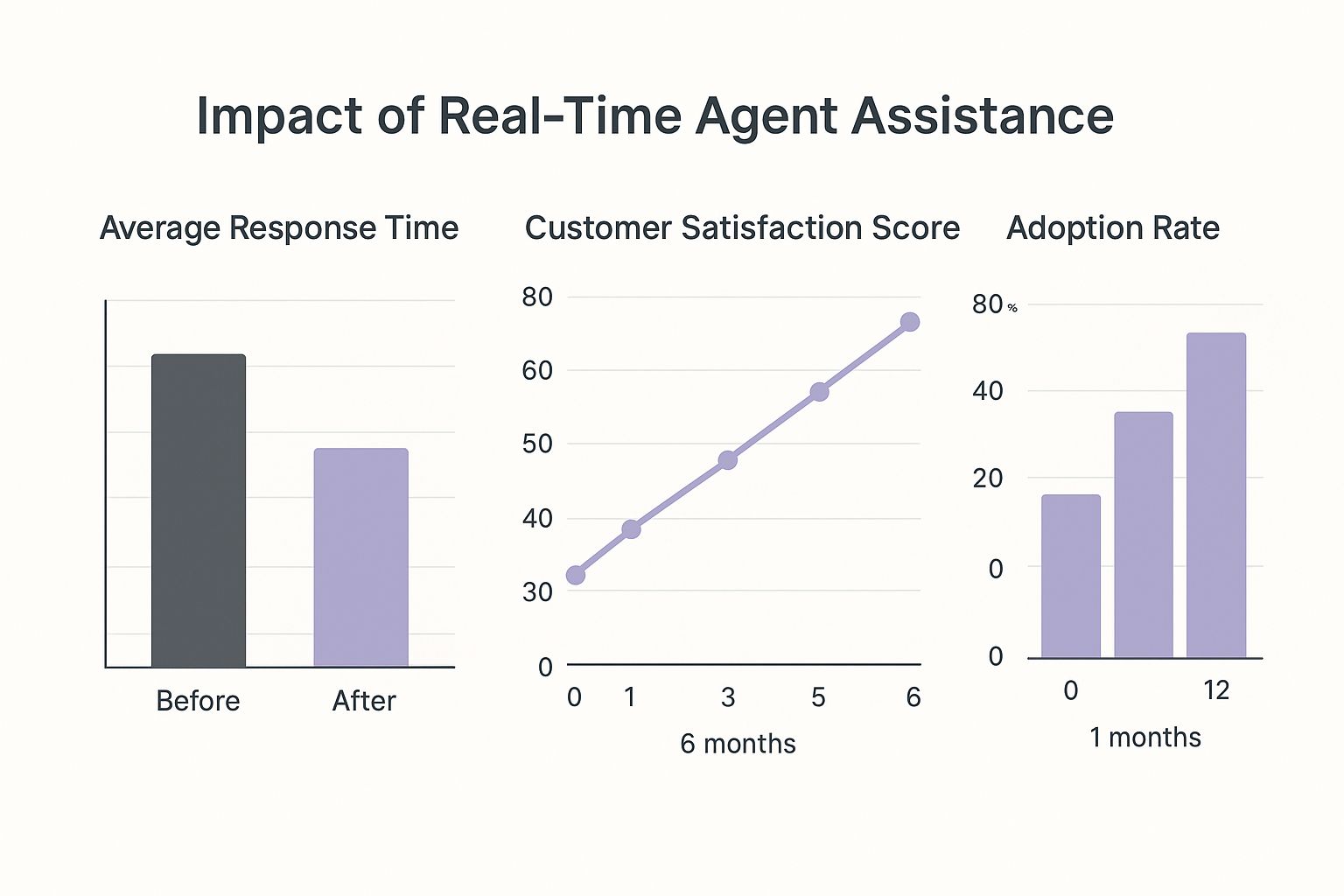Understanding Real-Time Agent Assistance That Actually Works
Real-time agent assistance is more than just a trendy term; it's a significant change in how businesses handle customer service. It empowers agents with the right knowledge at the right time, creating a smooth experience for both the customer and the agent. This means going beyond simple scripts and using AI-powered tools that understand context and predict customer needs. This shift is driven by the need for faster, more efficient, and personalized customer interactions.
How Real-Time Agent Assistance Works
Real-time agent assistance uses artificial intelligence (AI) to analyze ongoing customer conversations and give agents helpful information, suggested responses, and recommended next steps. For instance, if a customer asks about a specific product, the AI can instantly display product details, pricing, and availability, so the agent can quickly answer the customer's question. The AI can also analyze the customer's tone and sentiment, alerting the agent to potential frustration and suggesting ways to de-escalate the situation. This real-time support lets agents handle complex issues efficiently and deliver a personalized experience. Interested in learning more? Check out this article: How to master real-time agent assistance.
The Power of AI-Driven Insights
A key benefit of real-time agent assistance is its ability to provide data-driven insights that improve agent performance. By analyzing conversations, the AI can identify areas where agents excel and where they could improve. This information can be used to create focused coaching programs and personalized feedback, helping agents develop their skills and improve their overall performance. The AI can also track important metrics such as first-call resolution rates and average handle times, providing valuable data that businesses can use to optimize their customer service operations. AI agents are changing customer service by providing real-time assistance, personalization, and automation. As of 2025, the global AI agents market is valued at approximately $7.6 billion, up from $5.4 billion in 2024. This increase is driven by the growing adoption of AI agents across industries like retail, eCommerce, finance, and healthcare. Find more detailed statistics here.
The Future of Customer Service
Real-time agent assistance is rapidly transforming customer service. Traditional support models are becoming outdated as businesses adopt intelligent human-AI collaboration. This collaboration creates a better experience for customers, who get quick, personalized responses, and for agents, who can handle complex issues efficiently. The future of customer service lies in this partnership between humans and AI, where technology enhances human capabilities, not replaces them. This approach allows businesses to provide excellent customer service while improving agent productivity and lowering costs.

Market Growth Driving Real Business Transformation

The market for real-time agent assistance is booming, presenting significant opportunities for businesses. This isn't just about market growth; it's a fundamental change in how companies handle customer service and achieve a competitive advantage. Businesses that adopt real-time agent assistance early are already reaping the benefits. Meanwhile, those sticking with outdated systems are falling behind.
Industries Leading the Charge
Some industries are seeing a higher return on investment (ROI) with real-time agent assistance than others. Financial services and healthcare are leading the way. These sectors often navigate complex regulations and need to share highly accurate information.
Real-time agent assistance gives agents instant access to critical data. This ensures compliance and improves the accuracy of customer interactions. For instance, in financial services, it can guide agents through complex regulatory procedures, ensuring compliance and giving customers accurate information about their accounts.
In healthcare, real-time agent assistance can quickly provide patient records and medical information. This empowers agents to handle inquiries efficiently and accurately.
Investment and Regional Trends
Investment patterns and regional trends offer key insights into the market's future. Significant investment is pouring into developing and implementing real-time agent assistance solutions. This shows growing recognition of the technology's potential to reshape customer service.
Some regions are adopting these solutions faster than others due to factors like technological infrastructure and market maturity. Understanding these regional trends can help businesses find new opportunities and prioritize their investments. Strategically timing your market entry can greatly influence your potential for success.
Strategic Implications for Businesses
The rapid growth of the real-time agent assistance market has significant implications for businesses. The real-time AI agent assist market is expected to reach USD 124.6 billion by 2034. This growth is fueled by a compound annual growth rate (CAGR) of 39.70% between 2025 and 2034.
In 2024, the market size was USD 4.4 billion, highlighting the increasing demand for AI-powered customer service solutions. More detailed statistics can be found here. This rapid expansion signals a fundamental shift in customer expectations and the competitive landscape.
Companies that successfully integrate real-time agent assistance into their operations gain a considerable advantage. However, implementing this technology requires careful planning and execution. Businesses must consider factors like system integration, staff training, and change management to ensure a smooth transition. By learning from successful implementations, businesses can navigate this market transformation effectively and position themselves for long-term success.
Measurable Benefits That Transform Your Bottom Line
Real-time agent assistance is more than just a cool new tech feature; it's a game-changer for businesses looking to boost their bottom line. Companies using this technology are seeing impressive improvements in key performance indicators, leading to happier customers and lower operating costs. That’s a win-win in today's competitive landscape.
Quantifiable Improvements in Customer Satisfaction
Real-time agent assistance empowers agents to deliver faster, more accurate, and more personalized service. This results in a noticeable improvement in customer satisfaction scores. For example, some businesses implementing real-time agent assistance have reported a 40% increase in first-call resolution rates. This increased efficiency not only makes customers happy but also frees up agents to handle a larger volume of inquiries.
Real-time agent assistance also streamlines the customer experience by giving agents immediate access to customer data and knowledge bases. This minimizes hold times and eliminates the need for customers to repeat information, further enhancing customer satisfaction and fostering loyalty.
Cost Reductions and Increased Efficiency
Beyond happy customers, real-time agent assistance also provides significant cost savings. By automating routine tasks and optimizing agent workflows, businesses can drastically reduce operational expenses. This includes lower labor costs thanks to increased agent productivity and shorter training periods for new hires.
Agent burnout is also mitigated by providing on-the-spot support and simplifying complex tasks. This, in turn, leads to lower turnover rates. This saves businesses the significant costs associated with recruiting and training replacements. These saved resources can be reinvested into strategic growth initiatives. You might be interested in: How to master customer support automation.
Visualizing the Impact of Real-Time Agent Assistance
To better understand the impact of real-time agent assistance, let's look at some data. The table below compares traditional customer service with real-time agent assistance across several key metrics.
Real Time Agent Assistance Benefits Comparison A comprehensive comparison of traditional customer service versus real time agent assistance across key performance metrics
| Metric | Traditional Service | Real Time Assistance | Improvement % |
|---|---|---|---|
| First Call Resolution Rate | 50% | 70% | 40% |
| Average Response Time | 3 minutes | 1 minute | 66.7% |
| Customer Satisfaction Score | 75% | 85% | 13.3% |
| Agent Turnover Rate | 20% | 10% | 50% |
As the table demonstrates, real-time agent assistance can lead to a substantial jump in first call resolution rates, a significant decrease in average response time, and a notable improvement in customer satisfaction scores. In addition, agent turnover rate is halved. This highlights the effectiveness of real-time agent assistance in optimizing customer service operations.

The infographic above further visualizes the impact of real-time agent assistance on key metrics over time. It shows a notable reduction in average response time, a steady increase in customer satisfaction, and growing adoption rates within organizations. These benefits become even more pronounced over time, giving companies that adopt this technology a long-term strategic edge.
Implementation Strategies From Successful Deployments

Implementing real-time agent assistance effectively goes beyond simply installing new software. It requires a strategic approach that transforms your customer service operation. This involves considering various factors, from integrating the system and training staff to managing change and planning for long-term scalability.
Strategic Planning for Minimal Disruption
Successful deployments begin with a well-defined plan. This plan should clearly outline your objectives, identify key performance indicators (KPIs), and establish a realistic timeline. It's crucial to involve all stakeholders, including agents, supervisors, IT, and management. This ensures everyone understands their role and is aligned with the project's goals. You might be interested in: How to automate customer support.
A phased rollout is recommended to minimize potential disruptions. Starting with a pilot program within a small team allows you to test the system and gather valuable feedback. This approach helps identify and address any issues before deploying the system across the entire organization.
System Integration and Staff Training
Seamless integration with existing systems is essential, ensuring a secure SQL connection. Real-time agent assistance should complement your current tools, such as your CRM, ticketing system, or knowledge base, not replace them entirely. This integration ensures a smooth flow of information between systems, empowering agents to provide efficient and accurate service.
Effective staff training is paramount for successful adoption. Agents need to understand not only how to use the system but also how it benefits them. This involves addressing any concerns and highlighting the system's value in improving their workflow, reducing their workload, and ultimately, empowering them to better serve customers.
Change Management and Scaling for Growth
Introducing new technology often encounters resistance. Address this proactively through clear and frequent communication with your staff. Explain the reasons behind the change, the benefits it will bring, and how it will impact their roles. Involving staff in the process and addressing their feedback can turn skeptics into advocates.
Scaling operations effectively is key for long-term success. As your business grows, your real-time agent assistance system needs to scale accordingly. This means choosing a platform that can handle increasing volumes of customer interactions and seamlessly integrate with other systems as needed. Regularly evaluate your implementation, identify areas for improvement, and adjust your strategy to ensure continued success.
Measuring Progress and Ensuring ROI
Measuring progress is vital to ensure your real-time agent assistance implementation delivers the desired results. Track key metrics such as first-call resolution rate, average handle time, and customer satisfaction scores. This allows you to identify areas for improvement, measure the return on your investment (ROI), and make data-driven decisions. Continuous monitoring and adjustments are crucial for maximizing the system's effectiveness and achieving a positive ROI.
Future Innovations Shaping Customer Service Excellence
Real-time agent assistance is a dynamic field. New innovations constantly emerge, promising to elevate customer service and reshape the role of human agents. Forward-thinking organizations are already exploring these advancements to maintain a competitive edge.
The Rise of Predictive Assistance
One exciting development is predictive assistance. This technology goes beyond simply reacting to customer inquiries. It proactively anticipates customer needs. By analyzing past interactions and recognizing patterns, AI can predict a customer's next question and provide agents with the relevant information in advance. This proactive approach streamlines conversations, reduces customer effort, and creates a more personalized experience. For example, if a customer has previously contacted support regarding a specific product, the system can anticipate questions related to troubleshooting or upgrades.
Advanced Natural Language Processing
Natural Language Processing (NLP) is also rapidly advancing. Future iterations of real-time agent assistance will utilize more sophisticated NLP algorithms to better understand the nuances of human language. This includes recognizing sarcasm, idioms, and emotional cues, enabling AI to provide more contextually relevant and empathetic responses. Improvements in language translation will further enhance multilingual support, allowing businesses to provide seamless service to customers worldwide. This is increasingly important as companies expand globally.
The Evolving Role of Human Agents
These innovations are not designed to replace human agents. They are designed to empower them. As AI handles more routine tasks, human agents can focus on complex issues, building customer relationships, and providing the human touch that AI cannot replicate. This means the role of human agents is shifting toward more strategic and relationship-focused interactions. This shift will require new training programs and a focus on developing skills like empathy, critical thinking, and problem-solving. The future of AI agents is also bright, with market projections reaching $103.6 billion globally by 2032. This represents a staggering CAGR of 44.9% from 2024, a significant increase from the $3.7 billion valuation in 2023. Explore this topic further.
Ethical and Regulatory Considerations
As real-time agent assistance becomes more sophisticated, ethical and regulatory considerations will become increasingly important. Organizations must prioritize data privacy and security to protect customer information. Transparency regarding how AI is used in customer interactions is also essential for building customer trust. Forward-thinking organizations are already addressing these considerations by establishing guidelines and policies to ensure responsible AI implementation. This proactive approach will be crucial for building and maintaining customer confidence.
Choosing Solutions That Deliver Real Results
Picking the right real-time agent assistance solution is key to getting the most out of your investment. It means looking past the marketing buzz and zeroing in on the things that really move the needle. By carefully vetting potential vendors and asking the right questions, you can make sure your chosen solution delivers.
Essential Evaluation Criteria
First, define your specific needs and goals. What problems are you trying to solve with real-time agent assistance? Are you aiming to boost first-call resolution rates, shorten agent handling time, or improve customer satisfaction? Once you have a clear picture of your objectives, you can start evaluating potential solutions.
Here's what to consider:
-
Integration Capabilities: How seamlessly does the solution fit in with your existing CRM, ticketing system, and other platforms? Smooth integration is essential for top efficiency and avoiding data silos.
-
Scalability: Can the solution grow with your business? Pick a platform that can handle increasing customer interactions and data volume.
-
User Experience: How easy is the platform for your agents to use? A user-friendly interface encourages adoption and boosts agent productivity.
Unveiling True Capabilities
Vendors often show off polished demos and impressive features. But, it's important to dig deeper. Ask tough questions during vendor presentations, like:
- "Can you share case studies from similar companies?"
- "How does the solution handle complex issues that need to be escalated?"
- "What kind of training and support do you provide?"
These questions help you separate real capabilities from marketing fluff.
Assessing Total Cost of Ownership
Don't just look at the initial price tag. Consider the total cost of ownership (TCO), including implementation, maintenance, and customization costs. A thorough TCO analysis gives you a clearer picture of the long-term financial impact.
Structuring Pilot Programs
A pilot program is a great way to test a solution before a full rollout. Set clear goals for the pilot and identify key metrics to track. Choose a group of agents to participate and collect their feedback. This feedback will help you spot any issues and make adjustments before deploying it to your whole team.
Negotiation Strategies
Negotiating with vendors isn’t just about price; it’s about building a partnership. Clearly communicate your expectations and requirements. Be open to different pricing models and payment options. A solid contract that protects your interests and fosters a productive vendor relationship is crucial. Finally, remember to evaluate features based on their relevance to your needs. By understanding which features truly add value, you avoid paying for extras you don’t need.
To help you compare available platforms, here’s a handy table summarizing key information:
Real Time Agent Assistance Platform Comparison Side-by-side comparison of leading real time agent assistance platforms based on features, pricing, and capabilities
| Platform | Key Features | Best For | Starting Price | Integration Options |
|---|---|---|---|---|
| Flowgent AI | AI-powered agent assistance, knowledge base integration, live chat takeover | SMBs, agencies | $29/month | Website, WhatsApp, Slack, Instagram, Airtable, Notion |
| Balto | Real-time guidance, call scoring, coaching | Sales teams | Contact for pricing | CRM integrations |
| Chorus.ai | Conversation intelligence, sales coaching, deal analysis | Sales and customer success teams | Contact for pricing | CRM integrations |
This table offers a quick overview of some leading platforms. Remember to research each platform thoroughly to determine the best fit for your specific needs. Choosing the right solution involves careful consideration of your needs, budget, and long-term goals.
Key Takeaways And Your Action Plan
This section provides a practical roadmap for using real-time agent assistance to improve your customer service. We'll distill key insights into actionable steps you can implement right away. These strategies are designed to deliver results, no matter the size of your organization.
Prioritize Clear Objectives and Metrics
First, define clear objectives. What are you hoping to achieve with real-time agent assistance? Common goals include boosting first-call resolution rates, minimizing average handle time, and enhancing customer satisfaction. After defining your goals, choose specific metrics to track your progress. For instance, you could track the percentage of calls resolved on the first try or measure changes in customer satisfaction scores.
Phased Implementation for Success
Don't feel pressured to implement everything at once. A phased approach minimizes disruptions and allows for adjustments throughout the process. Begin with a pilot program including a small group of agents. This allows you to gather valuable feedback and spot potential issues before a full-scale launch. Think of it as a test run.
Empower Your Agents Through Training
Real-time agent assistance tools are effective only when your agents understand how to use them. Invest in thorough training that not only covers the technical side of the system, but also explains how it directly benefits agents. Highlight how the tool can lighten their workload and enable them to deliver better customer service. Empowered agents are far more likely to adopt the new technology.
Continuous Monitoring and Optimization
Implementing real-time agent assistance is not a set-it-and-forget-it project. It requires ongoing monitoring and optimization. Regularly review your chosen metrics and pinpoint areas for improvement. Ask yourself these important questions: Is the system meeting your initial goals? Are there unforeseen obstacles? Be ready to adapt your strategy based on the data collected. This continuous improvement is crucial for long-term success.
Your Action Plan: A Step-by-Step Guide
Here's a straightforward action plan you can begin using today:
- Step 1: Define Your Objectives. What are your primary aims for real-time agent assistance?
- Step 2: Choose Your Metrics. Which data points will you monitor to assess progress?
- Step 3: Select a Solution. Research and choose a platform that aligns with your specific needs and budget.
- Step 4: Implement a Pilot Program. Conduct a trial run with a small group of agents before fully rolling out the system.
- Step 5: Train Your Agents. Equip your agents with comprehensive training on effective use of the new system.
- Step 6: Monitor and Optimize. Regularly review your performance metrics and refine your strategy based on the data.
By following these steps, you can effectively implement real-time agent assistance and transform your customer service operations. Want to empower your agents and enhance the customer experience? Explore Flowgent AI today!


